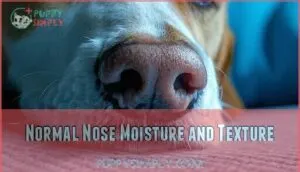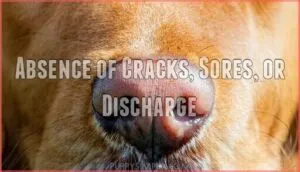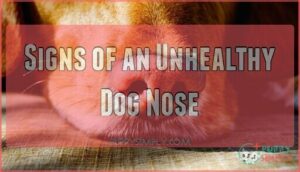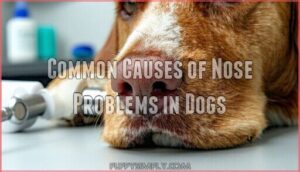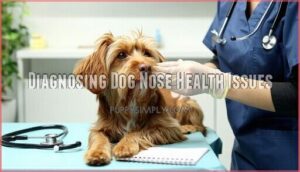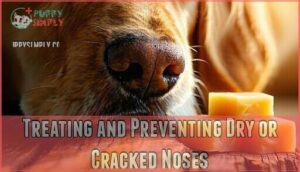This site is supported by our readers. We may earn a commission, at no cost to you, if you purchase through links.
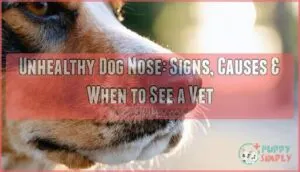
When something goes wrong, the signs often appear there first: cracks, discharge, discoloration, or unusual dryness. These changes can signal everything from minor irritation to serious underlying conditions that need prompt attention.
Understanding what separates normal variation from genuine health concerns helps you respond appropriately when your dog’s nose looks or feels different than usual.
Table Of Contents
- Key Takeaways
- What Does a Healthy Dog Nose Look Like?
- Signs of an Unhealthy Dog Nose
- Common Causes of Nose Problems in Dogs
- Diagnosing Dog Nose Health Issues
- Treating and Preventing Dry or Cracked Noses
- When to Seek Veterinary Care
- Frequently Asked Questions (FAQs)
- What does an unhealthy dog’s nose look like?
- When should I be concerned about my dogs nose?
- What does hyperkeratosis look like on a dogs nose?
- Should a healthy dog’s nose be wet or dry?
- What are the benefits of using Dog Bulldog Nose Butter?
- How can environmental factors affect dog nose health?
- What are signs of early stages of nasal cancer?
- Can diet influence a dogs nasal hydration?
- How does stress impact nasal health in dogs?
- Are there seasonal risks to a dog’s nose health?
- Conclusion
Key Takeaways
- A healthy dog’s nose should feel cool and damp like a moist sponge, with smooth tissue free from cracks, excessive dryness, unusual discharge, or sores—though color naturally varies by breed from black to pink or spotted.
- Warning signs requiring veterinary attention include persistent cracking, yellow or green discharge, nose bleeding that won’t stop, visible swelling affecting breathing, ulceration, or sudden texture changes like thick crusty buildup.
- Common causes of nose problems range from environmental factors like sun damage and cold weather to allergies, autoimmune diseases, infections, trauma, dehydration, and nutritional deficiencies—especially zinc or essential fatty acids.
- Treatment involves maintaining hydration and quality nutrition, applying dog-safe nose balms with natural ingredients like shea butter for minor dryness, and seeking immediate veterinary care for severe symptoms since serious conditions may require antibiotics, antifungal therapy, surgery, or radiation.
What Does a Healthy Dog Nose Look Like?
Before you can spot trouble, you need to know what normal looks like.
A healthy dog’s nose has a few telltale characteristics that signal all is well. Let’s walk through what you should see when you check your pup’s snout.
Normal Nose Moisture and Texture
Your dog’s nose should feel like a cool, damp sponge—not soaking wet, but pleasantly moist to the touch. This nose moisture helps your dog detect scents and maintain normal nasal passage function.
A healthy dog’s nose should feel like a cool, damp sponge—moist enough to detect scents, but never soaking wet
The skin should be smooth without rough patches or excessive dryness. Healthy nasal tissue feels slightly pliable when you gently touch it, and you shouldn’t see any unusual nasal discharge or crusting that interferes with proper dog nose hydration.
Variations in Nose Color by Breed
While moisture and texture tell you a lot about nose health, the color of your dog’s nose can range from jet black to pink, brown, or even spotted—and all of these can be perfectly normal depending on breed and genetics.
Nose pigmentation follows breed characteristics shaped by color genetics. A Labrador Retriever usually has a black nose, while breeds with lighter coats may show pink or liver-colored noses.
These nasal variations reflect natural canine morphology rather than health concerns, as long as the tissue remains smooth and free from unusual nasal discharge.
Absence of Cracks, Sores, or Discharge
Beyond the natural color variations that make each dog unique, a healthy nose should have one defining feature—a smooth, intact surface without any visible damage or discharge.
Regular nose inspection helps you spot early warning signs before minor issues become serious nose problems. Look for cracking, sores, or unusual drainage during routine canine skin care.
When healthy tissue regeneration occurs normally and nose moisture levels remain balanced, your dog’s canine nose stays resilient without needing intervention like nose balm applications.
Signs of an Unhealthy Dog Nose
While a healthy nose shows certain consistent traits, recognizing the warning signs of trouble is just as important. Your dog’s nose can reveal a lot about their overall health, and certain changes shouldn’t be brushed aside.
Let’s look at the key indicators that suggest your dog’s nose needs attention.
Dryness and Cracking
If your pup’s nose feels more like sandpaper than smooth leather, you’re likely noticing one of the most common signs that something’s off balance. Dry and cracked dog noses can signal environmental stress or underlying health concerns that deserve your attention.
Watch for these indicators of nasal dehydration:
- Visible cracked tissue or fissures across the nose surface
- Rough, flaky dry skin that persists despite normal activity
- Nasal hyperkeratosis where excess keratin builds up
- Skin lesions or peeling around the nasal area
Cracking often appears when your dog’s nose can’t maintain adequate moisture levels.
Unusual Discharge or Bleeding
Clear, healthy nose secretions differ from abnormal discharge patterns that signal trouble. When you spot yellow or green mucus, bloody drainage, or thick foul-smelling discharge from your dog’s nasal passage, you’re seeing red flags for bacterial, viral, or fungal infections—accounting for up to 34% of chronic nasal disorder cases. It’s vital to understand the nasal discharge causes to identify potential health issues in dogs.
| Discharge Type | Possible Underlying Cause |
|---|---|
| Yellow/Green Mucus | Nasal infections, fungal diseases |
| Bloody Discharge (Epistaxis) | Nasal tumors, trauma, clotting disorders |
| Thick/Opaque Drainage | Chronic infection, foreign body |
| Unilateral (One Nostril) | Localized issue, aspergillosis |
Pay special attention if nose bleeding persists or discharge lasts beyond three days—these unhealthy nose symptoms warrant veterinary evaluation to rule out serious epistaxis causes.
Swelling, Sores, and Texture Changes
When your dog’s nose starts showing visible bumps, raised patches, or rough leathery areas where smooth skin once was, you’re witnessing tissue changes that demand closer attention.
Nose inflammation and texture abnormalities often point to underlying conditions affecting nose health:
- Open nasal ulcers exposing raw tissue beneath
- Thickened, crusty plaques replacing normal nose texture
- Localized swelling obstructing the nasal passage
- Discolored skin lesions with irregular borders
- Painful nose sores your dog won’t let you touch
These unhealthy nose signs—especially when paired with behavioral changes—indicate swelling causes ranging from autoimmune disease to infection requiring veterinary diagnosis.
Hair Loss and Crusting
Patches of missing fur around your dog’s nose—especially when paired with yellow-brown crusts or flaky buildup—signal inflammatory processes that shouldn’t be brushed off as minor irritation.
Nose crusting often accompanies skin infections affecting hair follicles, creating nasal lesions that worsen without intervention. You’ll notice cracked nose tissue beneath the crust, sometimes with sticky nose discharge cementing the debris in place.
Don’t attempt crust removal yourself—proper canine nose care for dogs requires veterinary assessment to address the underlying dog nose health issue.
Common Causes of Nose Problems in Dogs
Your dog’s nose can tell you a lot about their overall health, but pinpointing the exact cause of nose problems isn’t always straightforward. Multiple factors can contribute to dryness, cracking, or other changes in your dog’s nasal tissue.
Let’s look at the most common culprits behind these nose issues.
Environmental Factors (Heat, Sun, Cold, Wind)
Your dog’s nose faces the elements head-on every day, and weather conditions can take a surprising toll on that sensitive skin. Extreme heat can lead to dehydration and heat stroke, while increasing the risk of dry noses. Sun damage causes sunburn and painful cracking. Cold stress and wind burn strip away natural moisture, leaving the tissue vulnerable to environmental factors.
- Heat exposure: Prolonged sun can cause dehydration and cracked nasal tissue
- Sun damage: UV rays lead to sunburn, especially in light-pigmented noses
- Cold stress: Freezing temperatures dry out the delicate nose surface
- Wind burn: Constant air movement removes protective moisture and causes irritation
Allergies and Autoimmune Diseases
Allergies and autoimmune diseases can trigger significant nasal problems in your dog. Allergic reactions cause rhinitis, conjunctivitis, and inflammation, while autoimmune conditions like pemphigus attack the nose’s delicate tissue.
These skin conditions often present with crusting, ulceration, and pigment loss. Certain breeds show genetic predisposition to autoimmune reactions, making early allergy testing vital.
Your vet may recommend nasal dermatitis evaluation through biopsy to assess immune system dysfunction and guide treatment. Understanding the role of autoimmune skin diseases is essential for effective diagnosis and treatment.
Infections and Upper Respiratory Issues
Nasal infections and upper respiratory diseases create visible changes to your dog’s nose. Viral agents like distemper and parainfluenza often trigger acute rhinitis, while bacterial causes—including Pasteurella and Moraxella species—produce discharge in over 70% of cases. Fungal agents such as Aspergillus affect the upper airway, causing hemorrhagic discharge and tissue ulceration.
These respiratory system infections may present with sneezing, epistaxis, or crusting around the nostrils, signaling deeper dog health issues requiring prompt evaluation.
Trauma, Injury, and Foreign Bodies
Physical damage to the nasal area—from rough play, collisions, or embedded debris—can quickly turn a healthy nose into a source of concern. Trauma symptoms range from mild abrasions to severe nose lacerations requiring nose reconstruction. Foreign object removal should always be left to your vet to prevent further nasal irritation.
Common nose injuries include:
- Scratches from rough surfaces or contact with sharp vegetation
- Puncture wounds from fights or encounters with wildlife
- Embedded plant material like foxtails causing persistent inflammation
- Blunt force trauma resulting in swelling or fracture
Injury prevention protects your dog’s delicate nasal tissue and promotes overall nose care for dogs.
Dehydration and Poor Nutrition
While external hazards pose obvious risks, what your dog eats—and drinks—directly affects the condition of their nose from the inside out. Dehydration signs like persistent dryness often reflect inadequate water intake, while nutrient deficiency from a poor diet compromises skin integrity. Malnutrition effects extend beyond general dog health to visible canine health markers—your dog’s nose being one of the first to show distress.
| Nutritional Factor | Impact on Dog Nose |
|---|---|
| Inadequate water intake | Dry, flaky nasal tissue with reduced moisture |
| Zinc or vitamin deficiency | Cracking, crusting, and poor tissue repair |
| Low-quality protein sources | Weakened skin barrier and slower healing |
| Essential fatty acid depletion | Loss of natural oils causing rough texture |
Focus your hydration tips on fresh water availability and consider pet nutrition adjustments if dryness persists despite environmental care.
Diagnosing Dog Nose Health Issues
When your dog’s nose shows signs of trouble, a proper diagnosis is the first step toward getting them back to health. Your vet will use a combination of techniques to pinpoint what’s causing the problem.
Here’s what you can expect during the diagnostic process.
Visual and Physical Examination
A close look at your dog’s nose can reveal subtle clues that something isn’t quite right, and learning what to check for takes just a few moments of careful observation.
During a nose inspection, you’ll want to check the skin for texture changes like thickening or rough patches that suggest nasal hyperkeratosis. Look for visual cues such as a cracked nose, sores, or a persistently dry nose that doesn’t improve with nose licking, as these physical signs often point to underlying conditions requiring diagnostic techniques.
Medical History and Symptom Assessment
Beyond what you can see on the surface, your vet will ask about timing, exposure, and behavioral changes to connect the dots between your dog’s symptoms and their underlying cause.
A thorough medical review during a nose examination includes symptom tracking—when the dryness or nasal hyperkeratosis started, whether your dog shows dehydration signs, and any environmental triggers.
This health screening provides essential dog health indicators before moving to diagnostic tools in veterinary medicine and diagnosis.
Laboratory Tests and Imaging
Your vet may recommend Blood Tests, including complete blood counts and biochemistry profiles, to screen for infections or inflammation. Imaging Studies like radiographs or CT scans reveal structural changes—tumors, sinus involvement, or turbinate destruction—that aren’t visible externally.
Diagnostic Protocols often incorporate Molecular Analysis such as PCR panels to identify viral or bacterial pathogens. In some cases, Biopsy Procedures provide definitive answers when neoplasia or autoimmune disease is suspected, completing the Veterinary Medicine and Diagnosis workup.
Common Veterinary Diagnostic Procedures
Once your veterinarian suspects a specific condition, they’ll often turn to rhinoscopy—a minimally invasive procedure that threads a small camera through the nostril to visualize inflamed tissue, polyps, or foreign material lodged deep in the nasal passage. Nose endoscopy allows direct sampling for lab analysis, while nose biopsy removes tissue for histopathology when neoplasia appears likely.
These diagnostic tests integrate seamlessly with veterinary imaging and blood work, forming a thorough veterinary medicine approach that guides targeted treatment and bolsters long-term dog health and wellness.
Treating and Preventing Dry or Cracked Noses
A dry or cracked nose doesn’t have to be a permanent problem for your dog. You can take several practical steps to restore moisture and protect the delicate nasal tissue from further damage.
Here’s what works to keep your dog’s nose healthy and comfortable.
Hydration and Nutrition Tips
Keeping your dog properly hydrated isn’t just about preventing a dry nose—it’s the foundation that bolsters every system in their body, from skin health to kidney function. Guarantee fresh water is always available, as dehydration quickly compromises tissue integrity.
Feed high-quality food with nutrient balance that bolsters pet wellness from within. Omega-3 fatty acids and moisturizing diets containing adequate fat help maintain skin barrier function, directly benefiting nasal health and digestive health while bolstering overall dog wellness through veterinary care principles.
Protective Measures Against Weather
Extreme temperatures—whether scorching summer sun or biting winter wind—can damage your dog’s nose just as quickly as they affect your own exposed skin.
Apply sun protection like dog-safe balms before outdoor exposure, and limit time outside during peak heat to prevent dehydration and dry nose complications.
In cold weather, use weather barriers such as scarves or limit harsh weather exposure to protect against cracking. Cold care and heat safety aren’t luxuries—they’re essential dog nose care practices for pet health.
Use of Dog Nose Balms and Moisturizers
When your dog’s nose feels more like sandpaper than velvet, a quality nose balm can restore moisture and repair damaged tissue before minor dryness turns into painful cracks.
Look for dog nose care products with Nose Balm Ingredients like shea butter or coconut oil—Natural Remedies that deliver Moisturizer Benefits through Protective Coatings.
These Canine Skin Care essentials work by moisturizing dog noses and sealing in hydration, transforming dry noses back to healthy condition with consistent use.
Safe Ingredients and Application Techniques
Not all nose balms are created equal—ingredients matter just as much as application when you’re nursing delicate nasal tissue back to health. Choose Natural Oils and Nose Butters like shea or coconut oil that create Protective Barriers without chemical additives.
For Gentle Application of your dog nose balm, dab a small amount onto your fingertip and let your dog lick it first—this builds trust before you smooth Soothing Creams across the dog nose surface in light, circular motions.
When to Seek Veterinary Care
While you can often manage minor nose dryness at home, some symptoms warrant professional evaluation. Knowing the difference between a cosmetic concern and a medical emergency can protect your dog’s health. Here’s what to watch for and when it’s time to call your vet.
Warning Signs Requiring Immediate Attention
Some changes in your dog’s nose don’t give you the luxury of waiting—they demand action now. Seek emergency care immediately if you notice:
- Profuse nose bleeding that doesn’t stop within a few minutes
- Swelling accompanied by difficulty breathing or labored respiration
- Sudden ulceration with discharge suggesting infection
- Signs of dehydration like sunken eyes and lethargy
- Severe trauma with exposed tissue or foreign objects
These critical symptoms require urgent attention from your vet.
Monitoring Sudden Nose Changes
Even after the crisis passes, your dog’s nose deserves the same attention you’d give to any other part of their health—small shifts can reveal bigger problems before they escalate.
Track changes daily using this simple framework:
| What to Watch | Normal Variation | Veterinarian Alert |
|---|---|---|
| Texture | Slight dryness after sleep | Persistent cracking or thickening |
| Discharge | Clear, minimal moisture | Sudden discharge, colored or bloody |
| Color | Gradual seasonal fading | Rapid depigmentation or darkening |
Note fluctuations in your dog’s nose appearance, especially nose injury signs or dry nose patterns. Document unusual dog symptoms like nose infections or nasal tumors for emergency vet visits. Regular canine nose care helps you catch problems early.
Veterinary Treatments for Serious Conditions
Behind every diagnosis lies a treatment plan—and serious nasal conditions demand targeted veterinary interventions your dog can’t get at home. Your veterinarian will select from these approaches based on pet symptoms and diagnosis:
- Systemic Medications – Antibiotics treat bacterial infections affecting the nasal planum, while antifungal treatments like clotrimazole achieve remission rates between 85% and 94% for sino-nasal aspergillosis.
- Minimally Invasive Procedures – Sinuscopy with topical antifungals avoids trephination, with all treated dogs achieving negative fungal cultures after a median of 2 treatments.
- Nasal Surgery – Planectomy removes malignant nasal tumors, achieving complete excision in over 90% of cases with median survival times around 496 days.
- Radiation Therapy – Palliative protocols improve clinical signs like epistaxis in 84% of dogs with intranasal tumors.
Urgent care interventions may include intravenous fluids, diagnostic imaging, or nutritional support depending on severity.
Long-Term Nose Health Maintenance
After treatment resolves the immediate concern, your dog’s nose will need ongoing attention to prevent future problems and catch early warning signs before they escalate.
Establish a routine that includes regular inspection during grooming sessions and monitoring for texture changes, discharge, or persistent dryness. These preventive measures support long-term canine hygiene and dog health and wellness.
| Dog Nose Care Tips | Frequency |
|---|---|
| Visual inspection for cracks or sores | Daily |
| Apply protective balm in harsh weather | As needed |
| Monitor hydration and nutrition | Ongoing |
| Document any changes in appearance | Weekly |
| Schedule veterinary wellness exams | Annually |
Consistent health monitoring keeps pet health and hygiene at its best while catching canine nose health problems early.
Frequently Asked Questions (FAQs)
What does an unhealthy dog’s nose look like?
An unhealthy dog nose often displays excessive dryness, cracked skin, nasal ulcers, or abnormal discharge types. You might notice nose lesions, sores, swelling, crusting, or nose deformity that wasn’t present before.
When should I be concerned about my dogs nose?
Trust your gut—if something seems off, it’s worth checking. Be concerned when you notice persistent dryness, cracks, unusual discharge, bleeding, swelling, sores, or sudden color changes.
These dog nose lesions and nasal tissue damage signs warrant a veterinarian visit to address potential dog health issues.
What does hyperkeratosis look like on a dogs nose?
Hyperkeratosis on a dog’s nose appears as thick, crusty buildup resembling dry layers of extra skin. You’ll notice rough, hardened patches that look almost horn-like in texture, often with a gray or brown discoloration that makes canine nose health concerns obvious.
Should a healthy dog’s nose be wet or dry?
A healthy canine nose naturally shifts between moist and dry throughout the day. Nose moisture levels fluctuate based on activity, environment, and hydration. Your dog’s nose doesn’t need constant wetness to indicate wellness—both states are normal.
What are the benefits of using Dog Bulldog Nose Butter?
Specialized nose balms like Nose Butter offer deep hydration through natural ingredients that create a protective barrier against environmental irritants. Regular application combats dryness and cracking while promoting healthy canine nose tissue.
These pet wellness products support proper dog nose care without harsh chemicals.
How can environmental factors affect dog nose health?
Weather exposure and climate impact markedly influence your dog’s nasal health. Temperature effects, humidity levels, and air pollution can cause dryness and cracking, while dehydration from environmental factors affecting dogs contributes to dog nose health problems and dog allergies and nose issues.
What are signs of early stages of nasal cancer?
Early detection matters. Watch for persistent one-sided nasal discharge, recurring nosebleeds, facial swelling near the muzzle, difficulty breathing through one nostril, or visible nose lesions that don’t heal—all potential cancer symptoms requiring immediate veterinary evaluation.
Can diet influence a dogs nasal hydration?
Diet plays a direct role in dog nose health through nutrient balance and hydration levels. Omega-rich foods support moisture content in nasal tissue, while food allergens can trigger dryness.
Adequate water intake from wet food helps prevent dehydration that affects canine wellness and overall pet health issues.
How does stress impact nasal health in dogs?
Chronic stress can trigger physiological changes in your dog that affect nasal health. Canine anxiety elevates cortisol levels, which may suppress immune function and increase susceptibility to nasal inflammation or nose bleeding.
Effective stress management promotes overall dog wellbeing.
Are there seasonal risks to a dog’s nose health?
Yes, each season brings distinct challenges. Winter dryness and cold winds can crack your dog’s nose. Summer heat increases risks of sunburn, dehydration, and heat stroke. Spring pollen triggers seasonal allergies, while autumn irritants contribute to nasal discomfort.
Conclusion
A retriever once came in with a nose that looked like dried leather—cracked, bleeding at the edges, and painful to touch. What seemed like simple dryness turned out to be an autoimmune condition requiring immediate intervention.
Your dog’s nose rarely lies about what’s happening beneath the surface. When you spot persistent changes—unusual discharge, deep cracks, swelling, or discoloration—you’re seeing your pet’s body asking for help. Recognizing an unhealthy dog nose early means catching treatable problems before they escalate into something far more serious.

